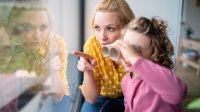Using ‘Know, Wonder, Learn’ to Broaden Students’ Learning
In “community KWL,” students ask their families what they know, wonder, and have learned about a topic to spark more questions to investigate.
Your content has been saved!
Go to My Saved Content.I learned about KWL the summer before my first year teaching, from my then–mother-in-law, an education professor. Beginning a unit by asking students what they know (K) and wonder (W) and ending by asking what they learned (L)—the idea delighted me.
When I explained KWL to Arlene, my assigned mentor, who’d been teaching for longer than the 24 years I’d been alive, she listened the same way she listened when one of her second graders discovered something that of course she already knew. She understood that learners like me needed to share the joy of knowing—which along with sharing the excitement of wondering and the satisfaction of learning, is exactly what KWL should be about.
I discovered how learning could affect the learner’s community, not as a beginning teacher but as a beginning mother, when my older child’s first-grade class did a yearlong interdisciplinary bird study. My child taught my husband and me how to identify various birds by sight and sound. We put a bird feeder in our yard and went hiking together. My dad downloaded a bird app for his phone. That bird unit, intended to create a context for first graders to learn in an integrated and sustained way, also created a context for our family to develop new affinities for the subject, for one another, and for learning itself.
What if, as educators, we created that context intentionally? What if one of our learning rituals involved exchanging gifts—the joy of knowing, the excitement of wondering, and the satisfaction of learning—with our communities?
From Traditional to Community KWL
Traditional KWL—for some teachers, the letters stand for “know, want to know, learn”—involves eliciting knowledge, wondering, and learning from students. In community KWL, students also ask family members, friends, neighbors, and anyone else they’re close to what they know about the unit topic, what questions they have about it, and what they’ve learned about it.
Sometimes, when students don’t know very much about a topic, they can think of things to ask but don’t necessarily find those questions interesting, challenging, or important. The student doesn’t yet see the topic’s relevance in their life and so doesn’t truly wonder about it. However, even if the student doesn’t have genuine questions about the unit topic, their family and community might. Let’s take as an example the phases of the moon, a topic that my child, now an eighth grader, recently studied in earth science class. Ey had no questions about moon phases, but our family had many: What stories do different cultural groups tell about moon phases? How do moon phases affect daily life? Why is the full moon associated with werewolves and madness?
I’m not arguing that these are the best questions about moon phases, that they belong in an earth science course (although some could be opportunities for interdisciplinary inquiry), or that an entire class should use a question to focus their learning just because one kid’s uncle asked it.
However, if one of KWL’s functions is to activate curiosity, asking community members for their questions about a unit topic could help students become curious themselves—perhaps because the questions link the topic to sources of meaning in the student’s life, or perhaps because a person they care about asked it. Asking questions could also activate community members’ curiosity, which could spur at-home research and discussions, which could in turn motivate classroom learning.
The L part of KWL comes at the unit’s end, when students reflect on what they’ve learned. In community KWL, you could simply send students home to ask their relatives, friends, and neighbors what they learned. Alternatively, you could communicate directly with families to inform them that the unit ended, tell them about any highlights, and invite them to share their answers to questions like the following (filling in the blank with the completed unit’s topic):
- What (if anything) did you learn about ___ as a result of your child studying it?
- What (if any) conversations did your family have about ___?
- What (if anything) might your family do to learn more about ___ in the future?
Answers to such questions let you know if the unit was accessible, responsive, relevant, affirming, and uplifting (or not, as the case may be). You can examine what families say as well as who reports back and how different families respond. If my unit evokes at-home conversation and extended learning only for White, wealthy, cisgender, heterosexual, Christian, neurotypical students, then I need to make my curriculum and pedagogy more equitable and inclusive. But if I get positive reports about home conversations from a diverse group of families, then I know that regardless of how well students did on an assessment task, they’ve fulfilled other overarching goals: continuing their learning beyond the unit and making their schoolwork meaningful beyond the classroom.
Community KWL has the potential to honor multiple knowledge sources, foster student wonder, extend student learning in their out-of-school lives, and help teachers learn. Perhaps most important, community KWL—especially if used as a learning ritual to begin and end every unit—shows students something I hadn’t yet learned when I first became a teacher: that they can contribute to many communities, not just because of their knowledge, but because of their relationships.
